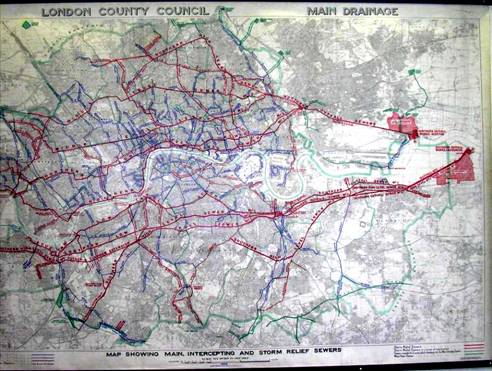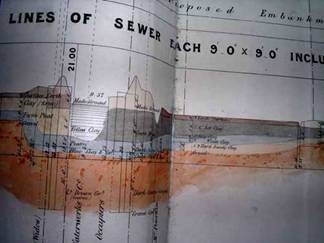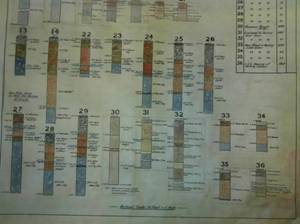
Harrow and Hillingdon Geological Society
Thames Tideway
Home | Monthly Meetings | Field Trips | Exhibitions | Other Activities | Members Pages | Useful Links
The Thames Tideway Project: or how to unpollute the Thames (again!).
Jackie Skipper
Jackie explained that she had obtained her PhD on the Lambeth Group at the Natural History Museum and Imperial College and she been involved in Thames Tideway at various times since 2000. The presentation covered:
- How the Thames got polluted;
- What happened to change the situation;
- How the Thames is still being polluted;
- What is the Thames Tideway Project and how will it improve the situation; and
- What is interesting geologically about the project.
How the Thames got polluted
Historically, the Thames was a wide river with tributaries flowing in from north and south, with marshes alongside the river, particularly on the south bank. Roman London developed where the City of London is now, with some development also on the south side of the river. The marshes and islands south of the river remained until drained by Dutch engineers in the 17 th-18 th century.
1400s – 1600s – During this period, all waste (including human waste) was left in the street or put in holes in the ground. After the Black Death in 1665, the belief that infection was caused by bad smells (miasma) led to attempts to clean up the streets. Water supply had been from wells or rivers from 1200 and this period saw the first pumped water supply to houses. Sewers were used for surface water drainage with human waste going to cesspools, for which payment was required to empty them.
1700-1848 – Water closets were developed, resulting in less smell but increased use of water meant cesspools overflowed and water use doubled in 6 years. At the same time the tributaries began to be built over to provide additional land. The development of steam power led to large increases in urban population. London’s population trebled from the 1760s to 1860. In 1815 connection of cesspools to sewers was permitted. In 1831-32, 6,536 people died of cholera in London alone and there were further outbreaks in 1848 and 1853. In 1849, flushing of sewers into the Thames was advocated to combat cholera.
1850s – people start to get worried – The Metropolitan Commission was set up to control sewers. There were new concepts of infection, moving away from the miasma theory with the work of John Snow in 1854. Michael Faraday carried out an experiment to test the transparency of water in the Thames in 1855 and 1858 was the year of “The great stink”. Joseph Bazalgette was empowered to construct a new sewerage system for London, which he designed to serve a population of 4.5 million (at a time when the population of London was about 1.5 million).
What happened to change the situation
The embankments – By 1866, most of London was connected to the sewer network designed by Bazalgette. In 1870, the Albert and Victoria Embankments were opened. These contained the interceptor sewer and the Metropolitan Railway (now the Circle and District Lines) and 52 acres of the Thames had been reclained for use as roads, walkways and parks. An important part of the system was the Abbey Mills and Crossness pumping stations, the “cathedrals of waste water”. This was the biggest engineering project in the 19 th century. Bazalgette’s legacy included detailed records with every borehole and trench recorded immaculately and now housed at Abbey Mills. The effect was to divert the problem downriver. The downside of this was reflected in 1878 when the Princess Alice, a pleasure cruiser was hit at Woolwich by the collier Bywell Castle and about 640 people died. This was the biggest peacetime nautical disaster in the UK. It was found that hundreds of the dead had been poisoned by the effluent and not drowned and most of those rescued died of dysentery.



1880s – 2000 – To prevent inland flooding Bazalgette had developed combined sewer overflows which permitted raw sewage to be pumped into the Thames at times of high flow and high rainfall. From 1887 to 1998, sludge from sewage treatment was shipped from Beckton and Crossness to Barrow Deep in the English Channel. Bazalgette’s system resulted in the Thames being much cleaner until the Second World War. Skimmers and bubblers have improved the Thames to the extent that it is the cleanest major river in Europe. As an illustration, Tubifex worms, which feed on raw sewage are now absent from the Thames.
Why is there now a problem again?
Bazalgette’s system was designed for a population of 4.5 million and London’s population is now 7.7 million. 32 million tonnes of untreated waste are routinely pumped into the Thames between Hammersmith and Beckton every year. Even moderate rainfall (2mm) overwhelms the system 60 times per year on average, resulting in periodic fish deaths and danger to 5-6,000 amenity users of the Thames. Because of the Thames’s formerly successful system, Thames Water is the worst polluter of the British water companies. Britain is in violation of Europe’s Urban Wastewater Treatment Directive, which could bring fines of up to £37,000 a day (£13.5m per year!) but the European Commission has agreed to suspend these penalties because London has a plan:
The Thames Tideway Project
This is a tunnel system which will intercept 36 out of the 57 worse Combined Sewage Outfalls. It comprises 32km of 7.2m internal diameter tunnel (9.0m external diameter) from Hammersmith and Fulham to Abbey Mills pumping station and a further 6.8km in the Lee Tunnel from Abbey Mills to Beckton sewage treatment works. About 40m deep at Hammersmith and Fulham, it goes down to about 75m below ground at its downstream end. It is designed to store water, which would currently discharge via combined sewer overflows, temporarily until treatment facilities are available. It is scheduled for completion in 2020 at a total cost of £2.2 billion.

Lee Tunnel – This 6.8km tunnel is the first stage of the project and is due to start tunnelling this year. Ground investigation started in 2006. The consultants had to plan where the boreholes should go and train the geotechnical team and the contractors in London geology (Chalk, London Clay and Lambeth Group and Thanet Sand Formation). Lots of boreholes were drilled to recover core, the logging was checked and the information was used to develop a ground model to predict how the ground will affect the tunnelling and the construction of the project.

Very little information was available between Abbey Mills and Beckton. 150mm cored boreholes down to 80m below ground level were required initially every 500m and subsequently every 200m. The phase 1 site investigation c0mprised 26 boreholes and Phase 2 comprised 14 boreholes. The succession comprises:
London Clay Formation-- Silty to slightly sandy CLAY
Harwich Formation -- Swanscombe Member-- Sandy shelly CLAY
Harwich Formation -- Oldhaven Member-- Clayey GRAVEL / SAND
Woolwich Formation Upper Shelly Beds Shelly CLAY
Reading Formation Upper Mottled Beds Blue grey mottled sandy CLAY
Woolwich Formation Laminated Beds Laminated fine sandy CLAY
Woolwich Formation Lower Shelly Beds Shelly CLAY
Reading Formation Lower Mottled Beds Blue orange red mottled CLAY with
variable sand and gravel
Upnor Formation Clayey SAND with variable gravel
Thanet Sand Formation Silty fine SAND – clayey towards base
Thanet Sand Formation Bullhead Bed Clayey, sandy flint GRAVEL
Seaford Chalk Moderately weak to weak white CHALK
The Chalk is very difficult to tunnel through because it has flints and lots of faults. The Upnor Formation is a green sandy clay with lots of fossils. The Lambeth Group is extremely variable. It was deposited as a marine deposit but underwent a long period of global warming (in the mid-Lambeth hiatus) and Lambeth Group sediments became weathered. The Woolwich formation is very stiff and hard and is faulted. It is 15m thick in most of London but its variability means you can see the faults. It also contains active minerals that oxidise in air, which led to 2 people dying in a tunnel in Stoke Newington in 1999.
The Plaistow graben is a newly discovered complex system of faults and the refinements in the ground model resulting from site investigation led to the decision to lower the Lee Tunnel at the Abbey Mills end to avoid the sandier Thanet Sands in this graben, and permit safer tunnelling. The Beckton anticline is notable since there is London Clay on one side of the river Thames and chalk on the other side. Ground investigation for Thames Tideway and the Lee Tunnel has shown there are far more faults in London than was previously realised even 5 years ago.
In the last year, huge shafts up to 40m diameter and up to 80m deep have been constructed and Thames Tideway design and the 3 rd site investigation is now happening. Most of the interceptor shafts alongside the Thames in central London will be in the Lambeth Group, which has its own geological challenges and the final position of many of them is subject to decisions in the planning system.
Conclusions
Thames Tideway is a new solution to an old problem (the pollution of the River Thames by discharged human waste.
Training and the maintenance of a good ground model is leading to much improved understanding of the geology of London.